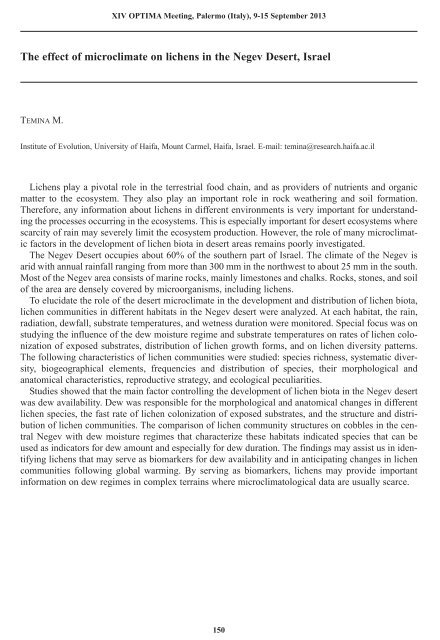Abstracts, XIV OPTIMA Meeting, Palermo (Italy) , 9-15
Abstracts, XIV OPTIMA Meeting, Palermo (Italy) , 9-15
Abstracts, XIV OPTIMA Meeting, Palermo (Italy) , 9-15
Create successful ePaper yourself
Turn your PDF publications into a flip-book with our unique Google optimized e-Paper software.
<strong>XIV</strong> <strong>OPTIMA</strong> <strong>Meeting</strong>, <strong>Palermo</strong> (<strong>Italy</strong>), 9-<strong>15</strong> September 2013<br />
The effect of microclimate on lichens in the Negev Desert, Israel<br />
TEMINA M.<br />
Institute of Evolution, University of Haifa, Mount Carmel, Haifa, Israel. E-mail: temina@research.haifa.ac.il<br />
Lichens play a pivotal role in the terrestrial food chain, and as providers of nutrients and organic<br />
matter to the ecosystem. They also play an important role in rock weathering and soil formation.<br />
Therefore, any information about lichens in different environments is very important for understanding<br />
the processes occurring in the ecosystems. This is especially important for desert ecosystems where<br />
scarcity of rain may severely limit the ecosystem production. However, the role of many microclimatic<br />
factors in the development of lichen biota in desert areas remains poorly investigated.<br />
The Negev Desert occupies about 60% of the southern part of Israel. The climate of the Negev is<br />
arid with annual rainfall ranging from more than 300 mm in the northwest to about 25 mm in the south.<br />
Most of the Negev area consists of marine rocks, mainly limestones and chalks. Rocks, stones, and soil<br />
of the area are densely covered by microorganisms, including lichens.<br />
To elucidate the role of the desert microclimate in the development and distribution of lichen biota,<br />
lichen communities in different habitats in the Negev desert were analyzed. At each habitat, the rain,<br />
radiation, dewfall, substrate temperatures, and wetness duration were monitored. Special focus was on<br />
studying the influence of the dew moisture regime and substrate temperatures on rates of lichen colonization<br />
of exposed substrates, distribution of lichen growth forms, and on lichen diversity patterns.<br />
The following characteristics of lichen communities were studied: species richness, systematic diversity,<br />
biogeographical elements, frequencies and distribution of species, their morphological and<br />
anatomical characteristics, reproductive strategy, and ecological peculiarities.<br />
Studies showed that the main factor controlling the development of lichen biota in the Negev desert<br />
was dew availability. Dew was responsible for the morphological and anatomical changes in different<br />
lichen species, the fast rate of lichen colonization of exposed substrates, and the structure and distribution<br />
of lichen communities. The comparison of lichen community structures on cobbles in the central<br />
Negev with dew moisture regimes that characterize these habitats indicated species that can be<br />
used as indicators for dew amount and especially for dew duration. The findings may assist us in identifying<br />
lichens that may serve as biomarkers for dew availability and in anticipating changes in lichen<br />
communities following global warming. By serving as biomarkers, lichens may provide important<br />
information on dew regimes in complex terrains where microclimatological data are usually scarce.<br />
<strong>15</strong>0






